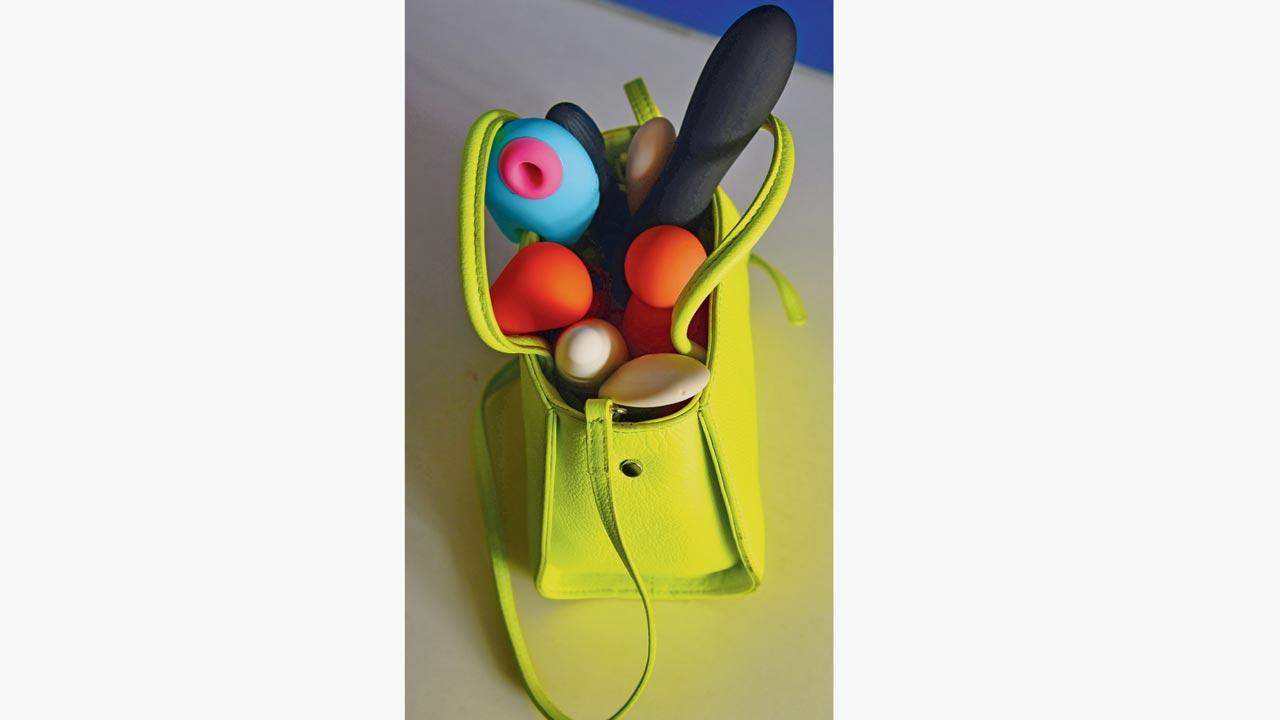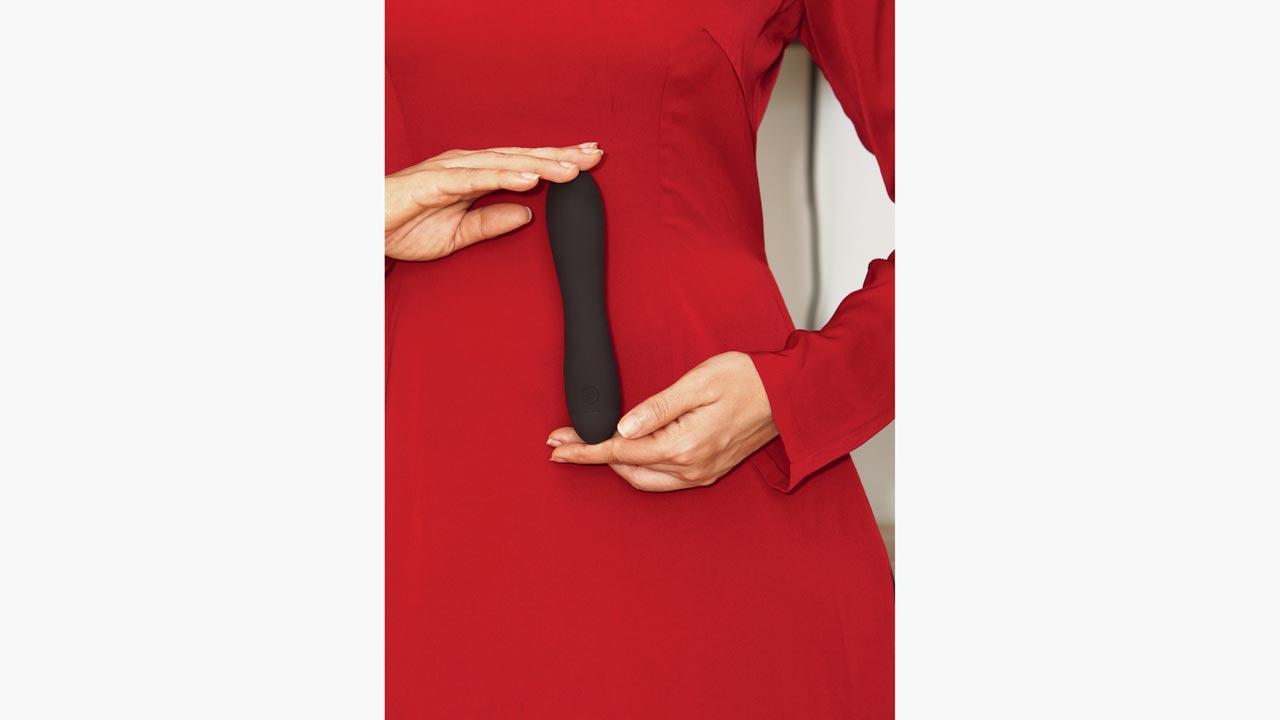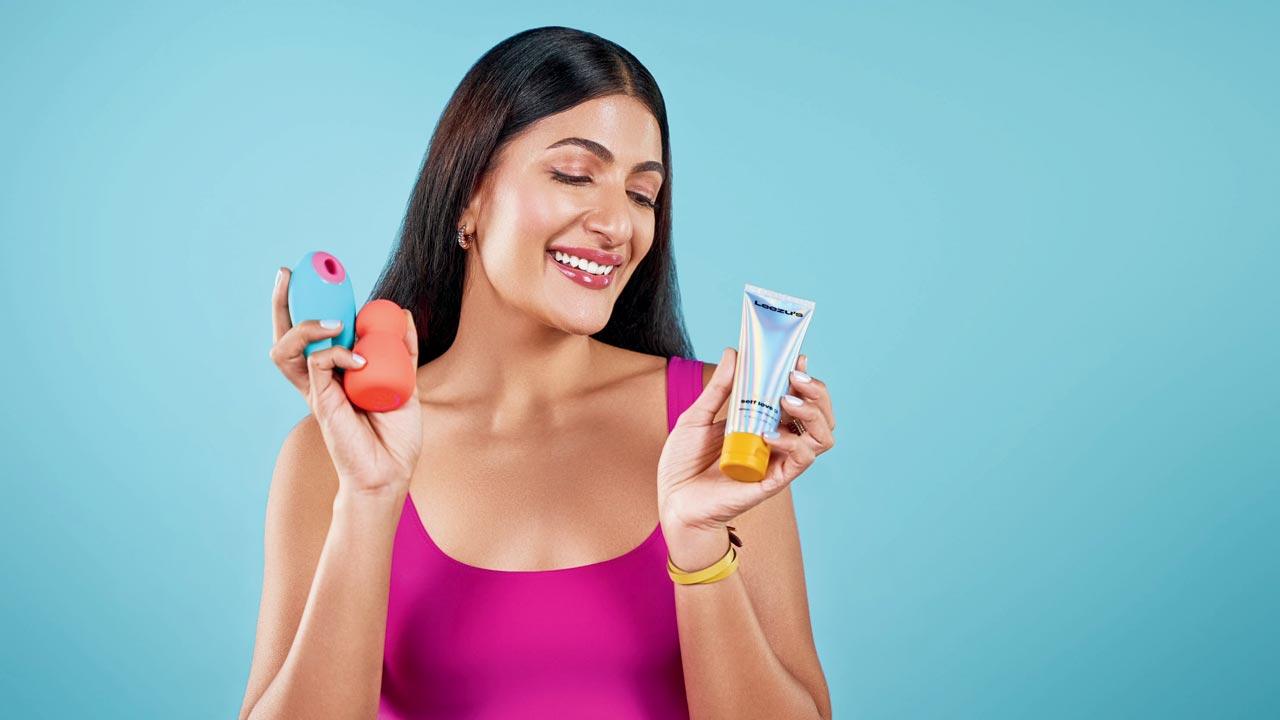Prudes won’t agree, but it’s a fact. The true Make in India moment is here with last week’s launch of the country’s first fully locally-made personal massager. Rising female purchasing power and the acceptance of sexual wellbeing as wellness means that pleasure tools are viewed not as symbols of loneliness, but part of play

Tanisha RK, Aashish Mehrotra and Shweta Sangtani are founders of sexual health startup Sangya Project. Tanisha was a sex educator for schools before she turned entrepreneur. Pic/M Fahim
They arrive at our office in a flurry of boxes: In playful yellow-peach-pinks, sophisticated black boxes, brand name emblazoned in fiery tangerine, a matt black one with just an Origami-bird on it. The office first responder asks whether he should put the package away in the fridge. Upon unpacking, they set off curiosity, mischief and giggles. As our Gen Z co-workers would put it, “The vibes are certainly vibing.”
Apart from one or two that give away their intention, the personal massagers are masked in elegance and playfulness. They look like minimalist household items: A bedside travelling alarm perhaps (Hulchul, by Leezu’s), a beauty product applicator a la the Gua Sha tool (Palm, by My Muse), and the latest entrant, the quietly forceful ninja (Sangya 1) that boasts of being made entirely in India.

There are several reasons for this: Though not specifically banned in India, pleasure products (and by extension, their exhibitors, advertisers, promotors, sellers, importers, exporters and manufacturers) can be targetted on grounds under Section 292 of the IPC.
But there are other reasons.
When the founders of the Sangya Project—Shweta Sangtani, Tanisha RK and Aashish Mehrotra—went local with Sangya 1, their first thought was to replicate their bestseller, the Sangya 8. “But we got rid of the ridges at the head, even though they ensure more pleasure,” says Mehrotra, “Because our research showed that many first-time users are intimidated, and prefer smoothness. Also, so many people’s first sexual experiences are trauma-informed. A pleasure tool like this could be their first step to discovering and exploring their sexuality [and being a crude replication of the anatomy would not help].” “The couple could be getting used to the idea of touch and understanding what they like,” explains Tanisha, who used to be a sex educator for schools, “before being with another person. We also wanted it to be safe around the house, if discovered by someone else…” “It’s neutral looking, not phallic,” says Sangtani, “It’s also not offensive to the manufacturer who looks at it just like s/he would creating another silicone sleeve for an electronic product. It doesn’t elicit shock, and more consumption leads to more conversion.”
 The Indian pleasure tool market was estimated to be worth $91.34 million in FY 2020 and is expected to grow at an estimated rate of 15.87 per cent until FY 2026. Pics/Nimesh Dave
The Indian pleasure tool market was estimated to be worth $91.34 million in FY 2020 and is expected to grow at an estimated rate of 15.87 per cent until FY 2026. Pics/Nimesh Dave
Leeza Mangaldas’s Pyaari and Hulchul are purposely playful. The cyan blue and pastel pink Pyaari launched in April 2023, was sold out within a week. And then again. Hulchul came in July in coral and pink, and both have caused befuddlement in our office because they look nothing like the male genitalia. “In order not to come under scrutiny for obscenity,” explains the pleasure positive content creator, “Indian pleasure brands opt for packaging without depictions of nudity. In any case, the direction that sex tech is going globally is that sexual pleasure products are increasingly designed to resemble any other cute electronic gadget intended for wellness, rather than the old-school approach which typically pandered to the male gaze and the idea that they are sleazy...”
This change in attitude, that rods that vibrate are for lonely, single women and lesbians, was a truth hardened by COVID-19. “So much awareness of pleasure and body autonomy grew from the loneliness we faced during the pandemic,” says Tanisha, “We discussed pleasure among the queer and women as a mental health need… what do we need as humans, versus what do you have to prove as a man. It became an approved part of wellness—sexual wellness is wellness too, not an ugly taboo. With that, pleasure tools began to be viewed not just as symbols of loneliness, but part of play.”
The market was well lubricated for entry.
 Sangya 1, India’s first fully-local made personal massager
Sangya 1, India’s first fully-local made personal massager
Mangaldas, who has proudly been a sex positive educator on the Internet for half a decade, echoes the collective realisation. “Most adults, whether rich or poor, urban or rural have sexual wellness needs,” says the author of The Sex Book: A Joyful Journey of Self-discovery, “[But] women still tend to receive the message that sex is primarily a marital duty, something to simply tolerate—for the sake of our husbands and to have children—not necessarily enjoy. Even when sex does feel good, the over emphasis on penetration as the central act often means that women don’t always prioritise their own pleasure, but rather have to hope that what feels good for their partner will also feel good for them.”
Through safe spaces on the Internet and online-based media, the phenomenon and recognition of the orgasm gap penetrated regular lexicon. “Pleasure in general is coming into focus right now,” says Akshay Jha, Creative Head at the Intimacy Curator, a Bandra-based collective that offers dating, intimacy and relationship coaching. “And there is more concentration on pleasure of female-bodied persons to balance out the over-emphasis on sex for ages, for cis gendered male
pleasure.”
Both Mangaldas and Jha are aware that this is the case only in a particular economic class. “In a hyper productive world,” says Aili Seghetti, founder of The Intimacy Curator, “we allow ourselves to think about pleasure only after we feel we have deserved it, or when the lack of pleasure and the abundance of stress impacts overall wellness and/or when we become aware that pleasure can make us more productive.”
 The Sangya Project, founded by Tanisha RK, Shweta Sangtani and Aashish Mehrotra, started as a sex education platform. They eventually began manufacturing pleasure tools
The Sangya Project, founded by Tanisha RK, Shweta Sangtani and Aashish Mehrotra, started as a sex education platform. They eventually began manufacturing pleasure tools
Senghetti also credits having more vulva owners in position of power for this re-orientation. “Bridging the pleasure gap and sexual empowerment are integral parts of the third and fourth wave of feminism. There is more investment in scientific research and product development. Even if this isn’t driven solely by having women in power, women’s purchasing power is ensuring the market offers what they want.”
And one of the reasons is education and financial independence which has empowered others too to focus on their pleasure. “Sex tech industries,” Jha says, “while profit driven, have realised the inequality in female pleasure vis a vis male pleasure” resulting in a thrust on female-centric and female-led brands. COVID-19 and the resulting social distancing played a major role in boosting the economy of the sex tech industry, and shifted focus to female pleasure, which is the prime market for personal toy brands.” “The value proposition for pleasure industries,” adds Seghetti, “is simple and appealing: pleasure and sex are good for you, they make you relax. When you relax, you stay healthy and can be more productive.”
As per estimates quoted by Research and Markets, the Indian Sex Toys Market was valued USD 91.34 million in FY2020 and is expected to grow at an estimated rate of 15.87 per cent until FY2026. “Anticipated growth in the market can be attributed to innumerable health benefits of inculcating sex toys for self-pleasure or in a relationship,” it said. Many brands rose to supply to the demand, their products charged and informed by technical, research-based information on what a woman really wants. The cat was out of the pants, such as the fact is that penetration alone does not result in orgasm. “And as the stigma begins to be dismantled,” says Mangaldas, “we are seeing a boom of new entrants in the sexual wellness space.”
 My Muse, founded by Anushka and Sahil Gupta, has discreet, minimalist and sculptural looking products that duck the moral radar
My Muse, founded by Anushka and Sahil Gupta, has discreet, minimalist and sculptural looking products that duck the moral radar
To add to the dilution of the taboo and stigma, most manufacturers are marketing the products as fun toys for couples to explore together—they are not just for her. “People realise these devices can actually be profoundly impactful to a more comfortable, more enjoyable, more self-aware sexual life,” says Mangaldas.
The Sangya project first started as a sex education space. When Tanisha realised the many limitations set “understandably” by the various stakeholders who were entrusting her to educate children who were not hers to raise, she switched lanes to educating adults so that they could disperse this information authentically, and without shame for them to pass on to their wards.
While they manufactured abroad for about two years, they shifted to home base owing to multiple factors that eventually lead to better consumer experience. “We are able to test whether the Sangya 1 stood up to rough manhandling during transportation,” says Mehrotra, “It is FDA approved and made using medical grade silicone. There’s one-year warranty and manufacturing here helps us facilitate easy exchanges and replacements.”
 Goa- based sex positive content creator Leeza Mangaldas’s line of intimate massagers are called Leezu’s
Goa- based sex positive content creator Leeza Mangaldas’s line of intimate massagers are called Leezu’s
Mehrotra, who openly talks about using pleasure products on Instagram, becomes an easy target. “I talked about using the stroker—a male pleasure product—I was trolled: You are not a man…” “You are not a ‘real’ man,” spouse Shweta interjects, “No, no,” he corrects, “Not a man only! There were comments like: You need this only if you can’t get a woman…” Ironically, Mehrotra, Sangtani and Tanisha are very vocal and open about being a throuple.
For Jha, conversations about pleasure tools are common given the space of work he is in. “Not really as common as say protein shakes or meditation, which are other things along with pleasure that are good for all of us,” he admits. He has used toys with a partner, and says, “It comes from abandoning all ego and having an open conversation about what pleases your partner. It is very important to listen and communicate without judgement.”
Mangaldas thinks: “Men stand to be able to unlearn a lot of the damaging misogynistic and queerphobic constructs around masculinity should they choose to explore their own bodies. Pleasure is actually a profound and important aspect of gender and sexual politics, and toys and lube are the unsung heroes of more equal pleasure for all. They also enable conversations in the bedroom—not only around arousal and pleasure, but also consent and boundaries: ‘Does this feel good?’ ‘Should I stop?’ It’s almost impossible to use these products during partnered play without talking about what you’re doing together.”
Thus, they turn catalysts for more honesty, vulnerability, self-awareness, and communication during intimacy.
How does the actual business of the business work? The Sangya Project found it hard to find a packaging partner. “We had to educate manufacturers that this is a tech product—just like a phone,” says Mehrotra, who has a marketing background. And there are different types, based on function, just like a phone. They are just manufacturing a silicone sleeve. We finally found a packaging partner, but he warned us it would take longer than usual, because as a man, he could not request the mainly women staffers to do this. It would be done by a male workforce at night.”
When Sangtani talks about what she does for a living, more often than not, the response is supportive: “They’ll say, ‘This is so necessary and important.’” “But relatives and family,” laughs Tanisha, “may say, ‘But does it have to be you?’ They’d prefer some distance from it.”
With Mehrotra, tellingly, the conversation is about business: Is there potential for growth? Is this a side hustle or do you pay yourself a salary? “I tell them this is a billion-dollar industry and ask them to name more than five players,” he says. They mostly can’t. And then comes his clincher: “Imagine how big my piece of the pie is.” The competition isn’t stiff, and sometimes, size does matter.
In all this talk of money, tools and trade, Seghetti sums it up well when she says: “The focus on female pleasure is great, but I wish there was less emphasis on physiological stimulation, and more around what turns us on psychologically, emotionally and relationally.”
Standing ovation, please.
 Subscribe today by clicking the link and stay updated with the latest news!" Click here!
Subscribe today by clicking the link and stay updated with the latest news!" Click here!










